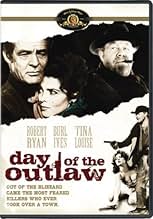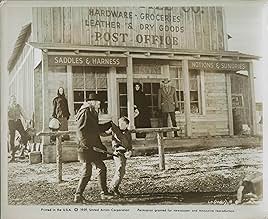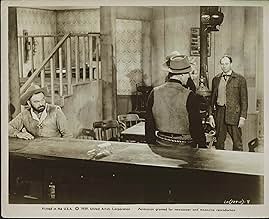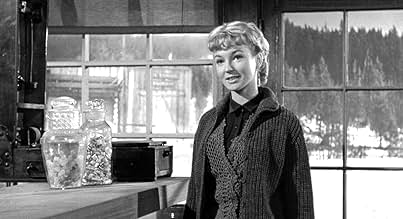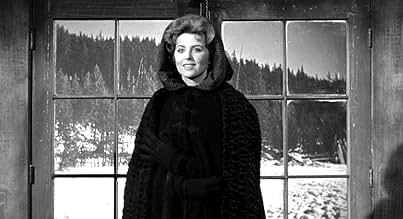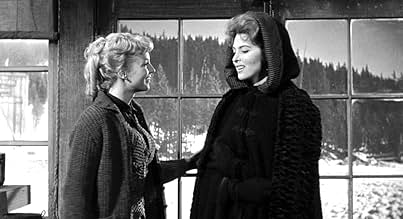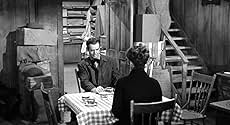Aggiungi una trama nella tua linguaBlaise Starrett is a rancher at odds with homesteaders when outlaws hold up the small town. The outlaws are held in check only by their notorious leader, but he is diagnosed with a fatal wou... Leggi tuttoBlaise Starrett is a rancher at odds with homesteaders when outlaws hold up the small town. The outlaws are held in check only by their notorious leader, but he is diagnosed with a fatal wound and the town is a powder keg waiting to blow.Blaise Starrett is a rancher at odds with homesteaders when outlaws hold up the small town. The outlaws are held in check only by their notorious leader, but he is diagnosed with a fatal wound and the town is a powder keg waiting to blow.
- Denver
- (as Frank deKova)
- Larry Teter
- (as Elisha Cook)
- Mrs. Preston
- (as Betsey Jones-Moreland)
- Bobby
- (as Mike McGreevey)
- Clagett
- (non citato nei titoli originali)
Recensioni in evidenza
"Day of the Outlaw" (1959) is a B&W psychological Western shot in the Oregon Cascades. It's similar to Westerns from the same period by Anthony Mann and Budd Boetticher, not to mention just as good or better. The protagonist (Ryan) isn't a hero, but rather a tortured man ready to make a last stand; meanwhile Bruhn (Ives) isn't wholly corrupted and still has some sense of nobility. Several of his hardened men, however, have clearly crossed over into the dark side.
Tina Louise, who would play Ginger from Gilligan's Island in 5-6 years, is younger & cuter here while Venetia Stevenson is nimble and winsome. You might remember Venetia from her jaw-dropping role in "The City of the Dead," aka "Horror Hotel" (1960).
Director Andre DeToth was having personal problems at the time of shooting and it affected the mood of the set, plus there were other issues, like snowstorm delays, Ryan missing a week due to pneumonia and DeToth changing his mind about scene locations at the last minute, etc. Perhaps the biggest problem was that the budget was low and, when they ran out of finances, DeToth & crew just packed-up and went back to Los Angeles.
Producers & editors had to make do with what was shot, which explains some weaknesses here and there. Scriptwriter Philip Yordan lamented "what could have been."
The movie runs 1 hour, 32 minutes, and was shot in central Oregon at Dutchman Flat & Todd Lake Meadows about 20 miles east of the town of Bend in late November thru early December, 1958.
GRADE: B+/A-
DAY OF THE OUTLAW isn't a great Western but it is different enough from the average film that it seems fresh enough to merit watching. What I particularly liked is how the first 15 minutes or so of the film turned out to be not at all directly related to where the film went next. Not knowing the plot, this really took me off guard--and I like when a film isn't easy to predict.
I also liked the idea of a gang of thugs invading and holding a town hostage--though this idea has been done before in Westerns (FIRECREEK) and non-Westerns (THE WILD ONE). What made this one stand out more from the others is that this group wasn't just bad in the usual sense, they were moral degenerates--rapists and sadists, not just socipaths or thieves. Plus, the idea of a strong but wounded leader (Burl Ives) trying to control these sick freaks was fascinating--as was the final showdown.
All in all, a very good film and one you should try to find due to its intelligent script and excellent acting.
By the way, one reviewer said they felt Burl Ives was wrong for the part since in real life he was a nice-guy folk singer. Well, with gritty previous roles in CAT ON A HOT TIN ROOF and THE BIG COUNTRY, I would certainly have to disagree with the sentiment, as Ives played the heavy in movies about as often as he played a good guy.
But the first hour is absorbing as well with its depiction of an one-horse town lost in the snow,a dead end where one never really knows which ones are prisoners and which ones are guards .The "ball ",during which the four women are really having a bad time (particularly Tina Louise)is one of the most violent scenes ever filmed in a western .And all they are doing is dancing.It has to be seen to be believed! Robert Ryan is ,as always,excellent ,as a tired blasé man who just wants to live in peace.
Unusual too is the absence of a good-guy hero. The two leads, Ryan and Ives, are both strong characters, but with a wobbly moral compass that wavers somewhere between low- down meaness and high-type nobility. In short, you never know what they're going to do. That makes for two interesting non-stereotypes to drive the plot. I expect one reason the film was passed over by critics is because of sexpot Tina Louise as an audience draw. Known more for her Amazonian measurements than her acting skills, she nevertheless does well enough here, while watching her get bounced around the dance floor, hair flying, is not anything you'll see her Ginger do on TV's Gilligan's Island. Speaking of vintage TV, there's Ozzie & Harriet's elder son David as a good kid who's fallen in with the wrong crowd, and a teenage Venetia Stevenson who looks and sounds more like a malt shop than a frontier town. Somehow, you just know they'll end up together.
Nonetheless, it's a payday for a lot of sturdy Hollywood veterans in supporting parts, including the always dependable Dabbs Greer and my favorite plug-ugly bad guy Jack Lambert. Then too, maybe you can figure out what Elisha Cook Jr.'s role is supposed to be, but who cares, just seeing the little fall-guy resonates across a couple of memorable Hollywood decades. And who better to manage scriptwriter Phillip Yordan's parade of shifting alliances than a central European like Andre de Toth, whose 1947 Western Ramrod remains another hidden gem. Anyhow, no movie that pits the steely Robert Ryan against the immovable Burl Ives can afford to be passed up, especially when stretched across an unusually polar landscape that still gives me the cold shivers.
Lo sapevi?
- QuizAndré De Toth had the town built in Oregon several months before filming so that the structures would be naturally weathered by rain and snow, not artificially dressed by crewmen. When De Toth learned that the workers had neglected to follow his compass headings for the layouts of the streets, he had them rebuild it.
- BlooperAt numerous times when they are going through the mountains, it is obvious that the horses are walking in plowed trenches.
- Citazioni
Helen Crane: [Dancing with Bruhn] Why did you have to do this terrible thing?
Jack Bruhn: There are things worse, ma'am, than dancing with lonely men.
Helen Crane: Please, let us go.
Jack Bruhn: Soon.
Helen Crane: Why did you have to come here?
Jack Bruhn: You should be grateful. Our coming saved the life of your husband.
Helen Crane: I don't believe Blaise would have gone through with it.
Jack Bruhn: Mrs. Crane, when my men and I leave here, there will be a showdown and you will be a widow.
- ConnessioniReferenced in The Adventures of Ozzie and Harriet: The Ladder (1953)
I più visti
- How long is Day of the Outlaw?Powered by Alexa
Dettagli
Botteghino
- Budget
- 400.000 USD (previsto)
- Tempo di esecuzione1 ora 32 minuti
- Colore
- Proporzioni
- 1.85 : 1
Contribuisci a questa pagina


